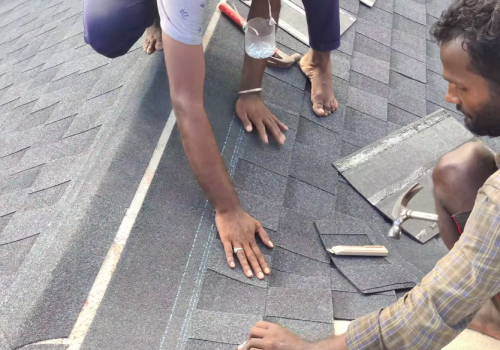Improving The Housing Development In Haiti With Better Roofs
To put it bluntly, building affordable housing in Haiti is challenging. Few measures have been successful in addressing Haiti’s housing crisis, which has been made worse by the immense destruction caused by the 2010 earthquake, despite the country’s dire need for decent and cheap housing. After the earthquake, worldwide building technology businesses, humanitarian relief workers, and non-governmental organizations (NGOs) flocked to Haiti to help with the reconstruction. The “Building Back Better” movement concentrated on the ways in which technology and design may enhance structural integrity, boost resilience, and reduce the damage caused by potential future disasters. In an effort to address the housing shortage, some 50 construction technology businesses participated in a housing exposition close to Port au Prince. However, many quickly discovered that building a successful housing project in Haiti is more difficult than they had anticipated, and the majority of these corporations withdrew without making any significant interventions. The comprehensive character of housing delivery, which is reflected by a number of additional “links” along the housing value chain, was overlooked by well-intentioned individuals.
While building technology and construction methods are essential to the delivery of housing, successful housing developments must address every link on the supply and demand sides of the value chain. Both the supply and demand sides of the value chain in Haiti encounter significant, challenging barriers. The value chain offers a comprehensive examination of the housing “environment.” When the two sides of the value chain, each with eight linked processes, function efficiently and at scale, a successful housing ecosystem is created.
We can look at the problem of land in Haiti as one supply-side illustration. Finding land with a clear title is the first significant difficulty that all developers in Haiti must deal with. NGOs and developers have bought property only to later have the ownership of that property disputed. Haiti’s land titling procedure is incredibly difficult, expensive, and time-consuming. Once the land has been acquired, building infrastructure on the property may cost more than a house is worth. Housing costs have increased as a result of the infrastructure and land titling bottlenecks, with some homes in Port au Prince starting at USD 300,000. This puts most Haitians out of their price range.
On the demand side, there is an imbalance in the purchasing power of Haitian households. Housing costs are driven higher by supply-side constraints, which causes a problem on the demand side of the value chain. Housing is much desired in Haiti, although there is little actual need. Banks are additionally risk averse and reluctant to grant mortgages or loans. Without a financing market, developers will have trouble selling their projects or may decide to divert their resources in another route. Due to undesirable locations far from areas of employment or without access to infrastructure, even free homes constructed with donor money are occasionally abandoned. The majority of the 3,000 homes built in Morne a Cabrit with Venezuelan funds are still unoccupied today. They were erected on a hill distance from Port au Prince.
As a result, the housing market in Haiti is difficult for donors to understand and a risky investment for private capital. There weren’t many successful large-scale housing constructions in Haiti up until recently.
Because they shield our homes from the elements, roofs are essential. When there are severe winds outside, your home can be protected by a sturdy roof. When it’s pouring rain outside, it can keep you dry. On a sizzling summer day, it offers some much-needed shade.
You might want to become familiar with some of the most popular roof designs and how they affect your choice of roofing materials if you’re getting a new roof or adding on to your home that requires additional roof space.
Roof Designs, Shapes & Styles
A roof may make up 40% of the outside of a home, depending on its architecture, and frequently contribute significantly to both its overall appearance and curb appeal. Therefore, when it’s time to construct a new roof, you should choose roofing materials and shingle colors that compliment the outside style of your home while also working well with the form and slope of your roof.
You can choose which shingles and roofing materials are best for your home by understanding the potential performance and design impact of various roof shapes and slopes. This will benefit you from both a performance and aesthetic perspective.
Roof Slope
Your roof’s slope serves both functional and cosmetic purposes. On a steep slope roof, for instance, water from rain or snow tends to shed, or run off, more quickly. Based on the dimensions of the roof, the slope of the roof is stated as a ratio.
Common Roof Types
Clipped Gable Roof
Bullnose is one of the names for the clipped gable roof. The upper peaks of clipped gable roofs are “bent in,” generating little hips at the extremities of the roof ridge. Clipped gable roofs have the same fundamental shape as a gable, with two sides rising to meet a ridge.
Dutch Gable Roof
Another hybrid style roof that has features from both gable and hip roofs is the Dutch gable roof. A conventional hip roof is situated above a tiny gable roof, or “gablet.”
Gambrel Roof
You may see a gambrel roof by visualizing a traditional red barn with white trim. Each of its two sides has two slopes, one gentle and one severe. The layout allows for either an attic room or a loft to be used on the upper floor. The upper floor can be used more often by adding windows to the sides of the gambrel roof, which will improve natural light.
Gable Roof
Remember the first house you drew with crayons? Most likely, you depicted a gable roof. It resembles a triangle in shape, with the house serving as the base and the two sides rising to meet the ridge. On the gable roof, slopes can be very different, ranging from steep chalet-style designs to rooftops with a mild inclination.
Hip Roof
Remember when you first drew a house using crayons? You most likely sketched a gable roof. In essence, it is shaped like a triangle, with the base resting on top of the house and the two sides rising to meet the ridge. The gable roof can have a wide range of slopes, from steep chalet-style structures to roofs with a mild grade.
Mansard Roof
The Louvre Museum in Paris is a superb illustration of the mansard roof, which borrows its traditional form from French design. The lower slopes of this four-sided design with double slopes, which might be flat or curved, are quite steep.
Shed Roof
A shed roof is probably something you’ll like if modern home designs are your thing. This “lean-to” design resembles a regular gable’s lower half. The shed roof has traditionally been used for porches and expansions, but in ultra-modern constructions, it now graces the entire building. Although steeper slopes would hasten water flow, most shed roofs have lower slopes, often 4 in 12 or less.
Flat Roof (Low Slope Roof)
Most people frequently picture strip malls and industrial buildings when they think of flat roofs. However, several mid-century modern architects experimented with flat rooflines between 1945 and 1970, building dream homes for wealthy businessmen and actors. Flat roofs complemented the style of the time, harmonizing with the surroundings and allowing for spacious, open floor designs. Some houses have a small amount of flat roof surface area and a gable or hip shape for the remainder of the roof. A flat roof may also be used in some home renovations to add more second-floor living space.




